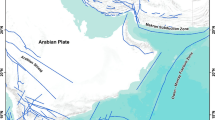Abstract
Near-field ground-motion records affected by directivity may show unusual features in the signal resulting in low-frequency cycle pulses in the velocity time history. Current probabilistic seismic hazard analysis (PSHA) is not able to predict such effects well; recent studies thus have proposed modified frameworks to incorporate pulse effect in modified PSHA. This paper attempts to carry out the seismic hazard mapping of Tabriz city according to modified and ordinary PSHA for different return periods. Tabriz, located in northwest of Iran, is situated in the vicinity of the North Tabriz Fault, which is one of the major seismogenic faults. Disaggregation results indicate that including pulse-like effects in PSHA, increases the relative contribution of close distances and small epsilons (ɛ). Another major probable result is the high contribution of pulse periods close to spectral period. The contributions to each earthquake scenario at long-period spectral acceleration shift to larger magnitudes with including the pulse effects.























Similar content being viewed by others
References
Abrahamson NA (2000) Effects of rupture directivity on probabilistic seismic hazard analysis. Paper presented at the sixth international conference seismic zonation, Oakland, California
Akkar S, Yazgan U, Gulkan P (2005) Drift estimates in frame buildings subjected to near-fault ground motions. Struct Eng 131:1014–1024
Ambraseys NN, Melville CP (1982) A history of Persian earthquakes. Cambridge University Press, Cambridge
Anderson JC, Bertero V (1987) Uncertainties in establishing design earthquakes. Struct Eng 113:1709–1724
Bazzurro P, Cornell CA (1999) Disaggregation of seismic hazard. Bull Seismol Soc Am 89:501–520
Bender B, Perkins DM (1987) SEISRISK III: a computer program for seismic hazard estimation 48
Boore MD, Atkinson MG (2008) Ground-motion prediction equations for the average horizontal component of PGA, PGV, and 5 %-damped PSA at spectral periods between 0.01 and 10.0 s. Earthq Spectra 24:99–138
Bozorgnia Y, Campbell KW (2003) The vertical-to-horizontal response spectral ratio and tentative procedures for developing simplified V/H and vertical design spectra. Earthq Eng 8:175–207
Chioccarelli E, Iervolino I (2012) Near-source seismic hazard and design scenarios. Earthq Eng Struct Dyn 42(4):603–622
Cornell CA (1968) Engineering seismic risk analysis. Bull Seismol Soc Am 58:1583–1606
Gardner JK, Knopoff L (1974) Is the sequence earthquakes in southern California, with aftershocks removed, poissonian? Bull Seismol Soc Am 64:1363–1367
Gutenberg B, Richter CF (1954) Seismicity of the earth and associated phenomena. Princeton University Press, Princeton
Hessami K, Pantosti D, Tabassi H, Shabanian E, Abbassi M, Feghhi K, Solaymani S (2003) Paleoearthquakes and slip rates of the North-Tabriz fault, NW Iran: preliminary results. Ann Geophys 46:903–915
Iervolino I, Cornell CA (2008) Probability of occurrence of velocity pulses in near-source ground motions. Bull Seismol Soc Am 98:2262–2277
Iervolino I, Chioccarelli E, Convertito V (2011) Engineering design earthquakes from multimodal hazard disaggregation. Soil Dyn Earthq Eng 31:1212–1231
Jackson J (1992) Partitioning of strike-slip and convergent motion between Eurasia and Arabia in Eastern Turkey and the Caucasus. Geophys Res 97:12471–12479
Kijko A, Sellevoll MA (1992) Estimation of earthquake hazard parameters from incomplete data files. Part II, incorporation of magnitude heterogeneity. Bull Seismol Soc Am 82:120–134
Kramer SL (1996) Geotechnical earthquake engineering. Prentice Hall, Upper Saddle River
Luco N, Cornell CA (2007) Structure-specific scalar intensity measures for near-source and ordinary earthquake ground motions. Earthq Spectra 23:357–392
Mavroeidis GP, Dong G, Papageorgiou AS (2004) Near-fault ground motions, and the response of elastic and inelastic single-degree-of-freedom (SDOF) systems. Earthq Eng Struct Dyn 33:1023–1049
McGuire RK (1995) Probabilistic seismic hazard analysis and design earthquakes: closing the loop. Bull Seismol Soc Am 85:1275–1284
McGuire RK (2004) Seismic hazard and risk analysis. Earthquake Engineering Research Institute, Berkeley
Mohajer-Ashjaee A, Nowroozi A (1978) Observed and probable intensity zoning of Iran. Tectonophysics 49:149–160
Nowroozi A (1985) Empirical relations between magnitudes and fault parameters for earthquakes in Iran. Bull Seismol Soc Am 75:1327–1338
Shahi KS, Baker JW (2011) An empirically calibrated framework for including the effects of near-fault directivity in probabilistic seismic hazard analysis. Bull Seismol Soc Am 101:742–755
Shoja-Taheri J, Naserieh S, Hadi G (2010) A test of the applicability of NGA models to the strong ground-motion data in the Iranian plateau. Earthq Eng 14:278–292
Somerville PG (2003) Magnitude scaling of the near fault rupture directivity pulse. Phys Earth Planet 137:201–212
Somerville PG (2005) Engineering characterization of near fault ground motion. Paper presented at the New Zealand society for earthquake engineering conference, Taupo, New Zealand
Somerville PG, Smith NF, Graves RW, Abrahamson NA (1997) Modification of empirical strong ground motion attenuation relations to include the amplitude and duration effects of rupture directivity. Seismol Res Lett 68:199–222
Spudich P, Chiou BSJ (2008) Directivity in NGA earthquake ground motions: analysis using isochrone theory. Earthq Spectra 24:279–298
Tothong P, Cornell CA, Baker JW (2007) Explicit-directivity-pulse inclusion in probabilistic seismic hazard analysis. Earthq Spectra 23:867–891
Wells DL, Coppersmith KJ (1994) New empirical relationships among magnitude, rupture length, rupture width, rupture area, and surface displacement. Bull Seismol Soc Am 84:974–1002
Zare M (2001) The risk of construction in neighborhood of North Tabriz Fault and seismic active faults across Iran. Earthq Eng Seismol Bull-Persian 4(2):46–57
Zare M, Sabzali S (2006) Spectral attenuation of strong motions in Iran. In: Proceedings, third international symposium on the effects of surface geology on seismic motion vol 1, pp 749–758
Author information
Authors and Affiliations
Corresponding author
Rights and permissions
About this article
Cite this article
Yousefi, M., Taghikhany, T. Incorporation of directivity effect in probabilistic seismic hazard analysis and disaggregation of Tabriz city. Nat Hazards 73, 277–301 (2014). https://doi.org/10.1007/s11069-014-1096-5
Received:
Accepted:
Published:
Issue Date:
DOI: https://doi.org/10.1007/s11069-014-1096-5




